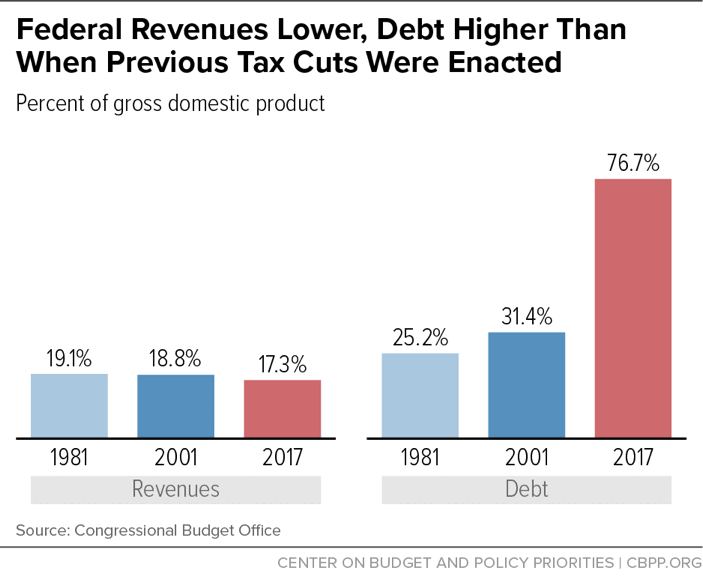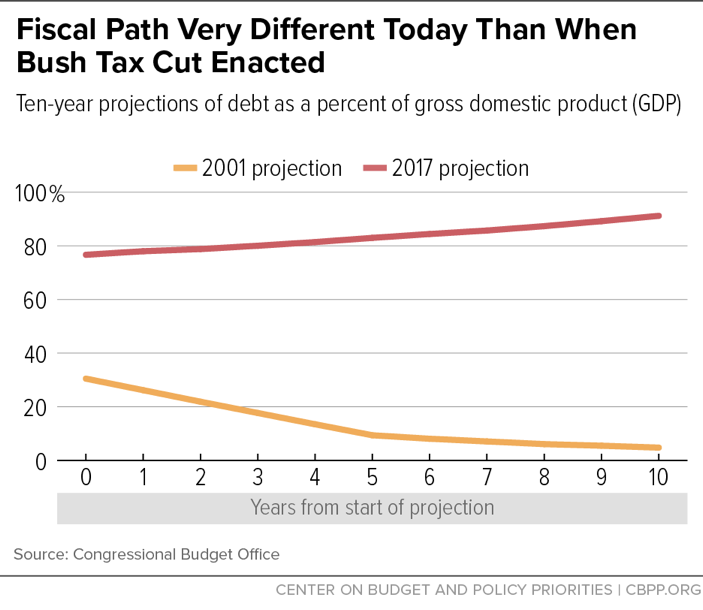The House Republican Tax Plan Is Fiscally Irresponsible
End Notes
[1] Chuck Marr, “Unpaid-for Tax Cuts for Wealthy Even Less Defensible Now Than in Bush Era,” Center on Budget and Policy Priorities, September 13, 2017, https://www.cbpp.org/blog/unpaid-for-tax-cuts-for-wealthy-even-less-defensible-now-than-in-bush-era.
[2] The budget resolution put in place a reconciliation process that allows a reconciliation bill that increases the deficit by no more than $1.5 trillion between 2018 and 2027 to pass in the Senate with only 50 votes (plus the Vice President). Technically, the permitted increase in the deficit is restricted to “on-budget” effects — that is, those outside Social Security and the Postal Service. The bill reported by the House Ways and Means Committee has on-budget revenue losses of $1.456 trillion over the decade, just under the $1.5 trillion allowed. Several provisions have an indirect effect on Social Security payroll revenues, which rise by $19 billion over the decade under the bill. When combined with the on-budget revenue changes, the net revenue loss on a unified basis is $1.437 trillion over ten years, according to JCT. See Joint Committee on Taxation, “Estimated Revenue Effects of H.R. 1, The ‘Tax Cuts and Jobs Act,’ As Ordered Reported by the Committee on Ways and Means on November 9, 2017,” JCX-54-17, November 11, 2017.
[3] Richard Rubin, “Republicans Bank on Future Congresses to Keep Family Tax Credit,” Wall Street Journal, November 3, 2017, https://www.wsj.com/articles/republicans-bank-on-future-congresses-to-keep-family-tax-credit-1509740274.
[4] Joint Committee on Taxation, “Estimated Revenue Effects Of The Chairman’s Amendment In The Nature Of A Substitute To H.R. 1, The ‘Tax Cuts And Jobs Act,’ Scheduled For Markup By The Committee On Ways And Means On November 6, 2017,” November 3, 2017, https://www.jct.gov/publications.html?func=startdown&id=5027.
[5] In particular, Congress has extended “bonus depreciation” on numerous occasions, including most recently in 2015, after it was first enacted on a “temporary” basis in 2008. See Chuck Marr and Brandon DeBot, “Ineffective ‘Bonus Depreciation’ Tax Break Should Remain Expired,” Center on Budget and Policy Priorities, November 13, 2014, https://www.cbpp.org/research/ineffective-bonus-depreciation-tax-break-should-remain-expired and Joint Committee on Taxation, “Description of H.R. 2510, A Bill to Modify and Make Permanent Bonus Depreciation,” September 16, 2015, https://www.jct.gov/publications.html?func=startdown&id=4828.
[6] Committee for a Responsible Federal Budget, “House Tax Plan May Add Over $2 Trillion to the Debt,” November 3, 2017, http://www.crfb.org/blogs/house-tax-plan-may-add-over-2-trillion-debt. Also, the package of amendments adopted at the end of the Ways and Means Committee consideration of the bill included a revenue-raising provision that would only take effect in 2023. The provision, which changes the tax treatment of research and experimentation expenditures, would raise $109 billion between 2023 and 2027. Businesses are likely to put significant pressure on policymakers to prevent the provision from going into effect; if they are successful, then the cost of the bill would be even higher.
[7] See Penn Wharton Budget Model, “The Tax Cuts and Jobs Act: Static Effect on Federal Tax Revenues,” November 6, 2017, http://budgetmodel.wharton.upenn.edu/issues/2017/11/1/the-tax-cuts-and-jobs-act-effect-on-federal-tax-revenues and Penn Wharton Budget Model, “The House Tax Cuts and Jobs Act, Amended (11/9/17): The Dynamic Effect on the Budget and the Economy,” November 13, 2017, http://budgetmodel.wharton.upenn.edu/issues/2017/11/13/the-house-tax-cuts-and-jobs-act-amended-11917-the-dynamic-effect-on-the-budget-and-the-economy.
[8] Emily Horton, “The Legacy of the 2001 and 2003 ‘Bush’ Tax Cuts,” Center on Budget and Policy Priorities, October 23, 2017, https://www.cbpp.org/research/federal-tax/the-legacy-of-the-2001-and-2003-bush-tax-cuts.
[9] Tax Foundation, “Details and Analysis of the 2017 Tax Cuts and Jobs Act,” November 7, 2017, https://files.taxfoundation.org/20171107102758/Tax-Foundation-SR239.pdf.
[10] See Chad Stone and Chye-Ching Huang, “Trump Campaign’s ‘Dynamic Scoring’ of Revised Tax Plan Should Be Taken With More Than a Grain of Salt,” Center on Budget and Policy Priorities, September 15, 2017, https://www.cbpp.org/research/federal-tax/trump-campaigns-dynamic-scoring-of-revised-tax-plan-should-be-taken-with-more. Furthermore, there are known errors with the Tax Foundation’s model that the Tax Foundation is currently taking steps to correct. See Greg Leiserson, “The Tax Foundation’s score of the Tax Cuts and Jobs Act,” Washington Center for Equitable Growth, November 9, 2017, http://equitablegrowth.org/research-analysis/the-tax-foundations-score-of-the-tax-cuts-and-jobs-act/.
[11] Council of Economic Advisers, “The Growth Effects of Corporate Tax Reform and Implications for Wages,” October 2017, https://www.whitehouse.gov/sites/whitehouse.gov/files/images/Corporate%20Tax%20Reform%20and%20Growth%20Final.pdf. See quote from Donald Marron in Nick Giampia, “Trump’s corporate tax cuts won’t increase wages by $4,000: fmr. acting CBO Director,” FoxBusiness, October 17, 2017, http://www.foxbusiness.com/politics/2017/10/17/trump-s-corporate-tax-cuts-wont-increase-wages-by-4000-fmr-acting-cbo-director.html. See also Lawrence H. Summers, “Lawrence Summers: One last time on who benefits from corporate tax cuts,” Washington Post, October 22, 2017, https://www.washingtonpost.com/news/wonk/wp/2017/10/22/lawrence-summers-one-last-time-on-who-benefits-from-corporate-tax-cuts/?utm_term=.b3d8a6ded4cd; and Chad Stone, “An Empty Pay-Raise Promise,” U.S. News & World Report, November 10, 2017, https://www.usnews.com/opinion/economic-intelligence/articles/2017-11-10/gop-tax-plan-over-promises-and-under-delivers-on-middle-class-tax-cuts.




